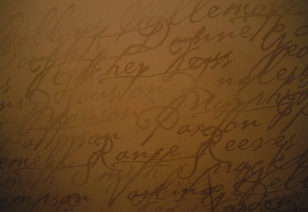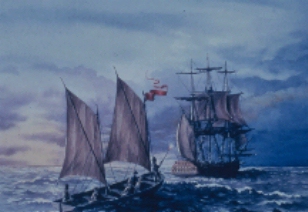
Figure 4: Image of Hamilton's diary.
Image used courtesy of the Queensland Museum
Pandora remained at Tahiti for a total of 47 days, 18 of which were spent rounding up the 14 mutineers. The remainder of the time was spent repairing the ship, replenishing supplies of food and water, and 'refreshing' the crew (Admiralty Records 1/1763; Coleman 1990). Pandora's surgeon, Hamilton, provides an excellent description of this period (Hamilton in Thompson 1915). Edward's primary concern now was to locate the Bounty and capture Fletcher Christian and the remaining mutineers. On 8th May 1791 Pandora sailed on the first leg of a fruitless three-month search of the major Polynesian island groups west of Tahiti (Admiralty Records 1/5330; Thompson 1915). However, by August Edwards was running short on supplies and had lost an additional 12 men when two boats became separated from the Pandora during heavy storms (Coleman 1990). Edwards decided that further efforts to locate the Bounty were not viable and on 15th August 1791 Pandora set course for Timor via the Torres Straits.

Figure 4: Image of Hamilton's diary.
Image used courtesy of the Queensland Museum
Eleven days later they arrived at the Great Barrier Reef and began to skirt the reef in a southerly direction in an attempt to find a safe passage through these treacherous and uncharted waters (Admiralty Records 1/5330). Early in the morning of 28th August a promising opening was sighted and a boat was launched to investigate. The launch was not sighted again until later that afternoon (Hamilton in Thompson 1915). Since it was almost dark, Edwards considered entering the passage too dangerous and decided to wait until the next morning.

Figure 5: Original painting by Bronwyn Searle depicts HMS Pandora manoeuvring to take on board one of its boats
shortly before running aground on the Great Barrier Reef in 1791.
Image used courtesy of the Queensland Museum
Whilst manoeuvring to pick up the boat, the Pandora struck an isolated outcrop of submerged reef. Damage caused to the hull was compounded by waves pounding the vessel further along the reef it had struck. The ship's carpenter soon reported a depth of almost 8 feet (2.5m) of water in the hold. The crew's frantic efforts on the pumps combined with a rising tide and wave action, enabled the ship to beat over the reef into deeper water, where the ship remained afloat and further damage to the hull ceased. At about 10pm that night she was brought to anchor in relatively sheltered waters behind the reef. The crew spent a desperate night trying to save their ship. However, the Pandora was doomed, and at first light on the 29th August 1791 Edwards consulted his officers and they agreed that nothing more could be done to save the ship (Admiralty Records 1/5330; Hamilton in Thompson, 1915, 144; Coleman 1990; Gesner 1991). The boats had already been launched and were now quickly provisioned for the crew's escape. Orders were given to cut loose from the deck any material that would float so that the men who could not swim would have a chance to be rescued by the boats. Immediately after these orders were given, Pandora heeled over, and sank within minutes (Coleman 1990).
Although last-minute efforts were made to save the mutineers from Pandora's Box, four did not survive. Additionally, thirty-one of Pandora's crew were reported drowned (Coleman 1990; Gesner 1991). The surviving 89 crew and ten mutineers spent the following three days on a nearby sand cay, preparing four boats for an open voyage to Timor.
While on the sand cay, and during the open boat voyage, the prisoners suffered unbearably. At noon on 1st September the four boats departed from the cay and started the 2100km journey to Timor. Their return trip to Timor, although extremely unpleasant (Gesner 1991), was relatively uneventful. Timor was sighted on 13th September and three days later they reached the settlement at Coupang. The authorities at Coupang took every step necessary to ensure all made a speedy recovery from their ordeal, with the exclusion of the mutineers. Their hardship continued as they once again found themselves remaining imprisoned until eventually standing trial in England.
After a six-day trial in September 1792, four of the mutineers were acquitted. The remaining six were found guilty and sentenced to be hanged for their part in the mutiny. However, only three of these death sentences were to be carried out. By recommendation of the court, two were pardoned and one case was discharged on a technicality. The remaining three mutineers were hanged in October 1792. The Court found Captain Edwards and his officers to be at no fault for the loss of Pandora.
© Internet Archaeology
URL: http://intarch.ac.uk/journal/issue11/4/8.html
Last updated: Thu Mar 28 2002